If you are wondering which pottery wheel to choose, this straight to the point guide will take you through some options to help you choose the most suitable, and therefore, the best pottery wheel for you.
The table below contains a summary of our top choices. But we also provide full reviews and information about what to look for as well. You can jump to each section from the table of contents below the table.
Choosing Your First Pottery Wheel
If you are just starting out, or just want to have fun and try your hand at throwing some pots, you probably don’t want to spend too much, and the good news is, the most expensive wheels, (which have centering capacities of 150 lbs and up) are frankly way more than you would need anyway.
So if you just want to have fun and not spend too much, for well under $200, our budget option is a pretty solid choice.
Alternatively, even if you have never thrown anything before, you may prefer to go for a step up from a basic pottery wheel. The Speedball Artista is an excellent choice for starting a new hobby.
It’s suitable for all skill levels. It’s practical and priced at under $500 it’s a lot more affordable than the full-sized ones. It also comes with a two-year warranty.
Tabletop Pottery Wheels
Tabletop pottery wheels are usually compact, and easily portable – the Speedball Artista and the Aspire Pottery Wheel by Shimpo are good examples. You can take them outside when the weather’s nice, and they’re convenient to carry with you to a pottery class.
Even as an experienced potter, you may just prefer to specialize in smaller pieces, so a compact tabletop pottery wheel may be all you ever need.
Some people do, however, struggle to find a suitable surface to place a tabletop pottery wheel on. You will need to find somewhere to position it at a comfortable height to work. But you may be able to find, or even make, a table that’s suitable for your tabletop pottery wheel.
Hand Operated vs Foot Operated Pottery Wheels
Tabletop pottery wheels may be hand-operated or foot-operated (via a foot pedal). On balance, hand-operated pottery wheels are generally easier to work with for a beginner. The simple reason is that it can be a little difficult to get the co-ordination right between changing the speed with your feet while working the clay with your hands. (The same is also true when learning to spin on a spinning wheel.)
Full-Size Pottery Wheels
If you’ve tried throwing on a wheel before, maybe you’ve taken some classes and, you know you’re not a quitter, I recommend you invest in a Brent EI.
Brent models may be more of a considered purchase but they outperform the cheaper ones by a mile.
They are ideal for a home studio set up and are built to last – well, basically forever.
| Brand | Details | View |
 Speedball Artista Potter’s Wheel |
The Perfect All-Rounder Speed: 0–220 rpm Wheel Head: 11″ Bats: 2 included. Centering Capacity: 25 lbs Warranty: 2-years Read Full Review |
Blick.com |
 Shimpo Aspire Pottery Wheel |
Small and Portable Speed: 0–230 rpm (hand-operated version) Speed: 0–250 rpm (foot-operated version) Wheel Head: 7″ Bats: 2 (9- 3/4″) Centering Capacity: 20 lbs Warranty: 5-year limited manufacturer’s warranty Read Full Review |
Blick.com |
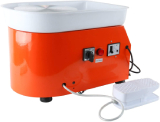 YaeTek Electric Pottery Wheel Machine |
Ideal Starting Kit for New Hobbyists Speed: 0-300 rpm Wheel Head: 9.84” Bats: 0 Centering Capacity: (Approx) 20 lbs Read Full Review |
Amazon |
 Brent Mode IE, B and C Power Wheels |
The Enthusiast’s Dream Setup Model IE Speed: 0–240 rpm Centering Capacity: 75 lbs. Bats: Plast-Bat 12″ Warranty: 5-years Models B and C Speed: 0–240 rpm Centering Capacity: (B)150lbs | (C)225 lbs. Bats: Plast-Bat (B)12″ | (C)14″ Warranty: 10-years Blick.com Amazon Read Full Review |
Model IE Blick.com |
Click below to jump to each topic in this guide.
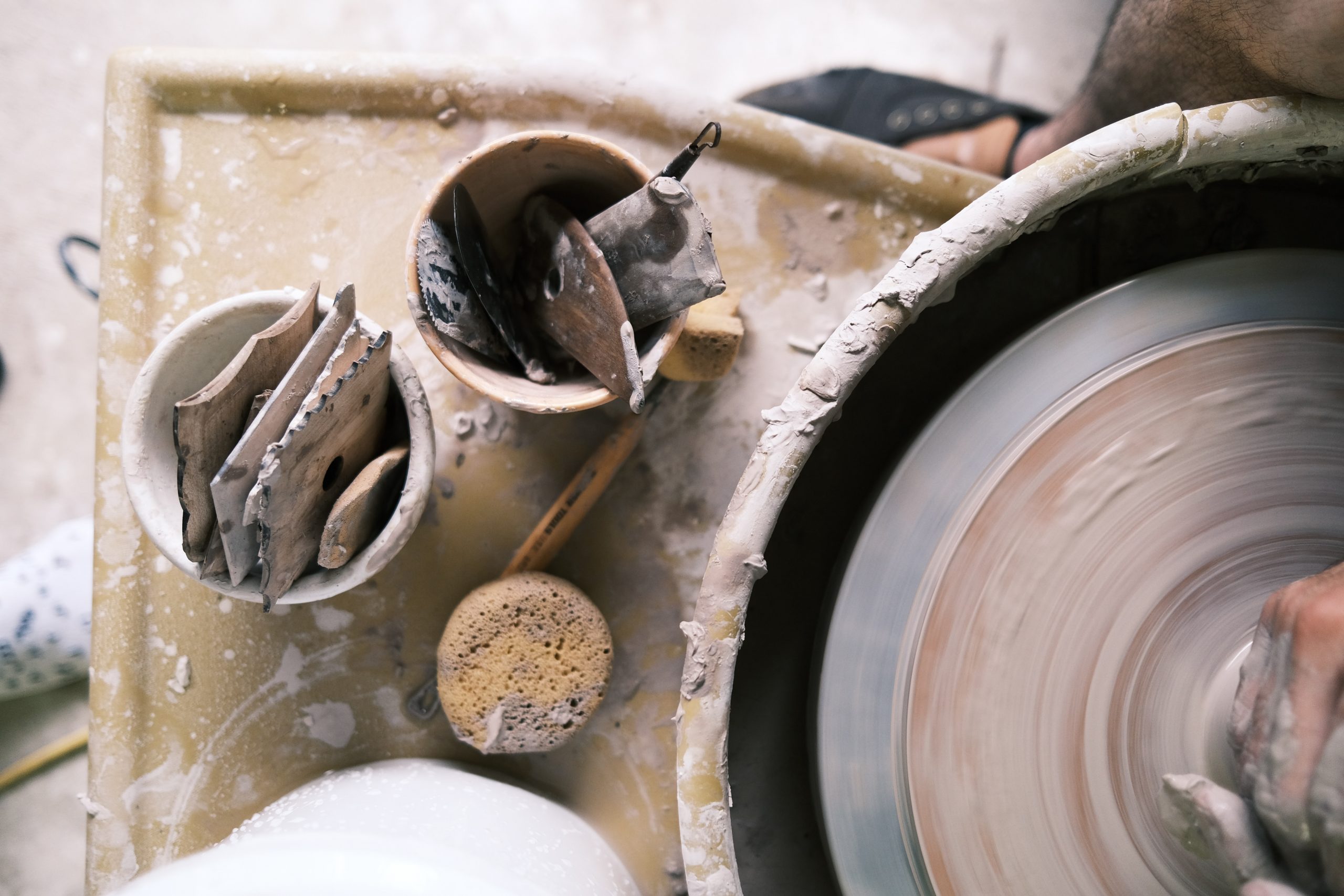
Our Top Pick | The Perfect All-Rounder: Speedball Artista Potter’s Wheel
The Perfect All-Rounder
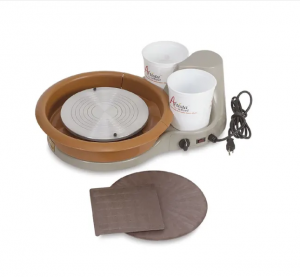
If like me, you are the crafty, creative type – even if you have never thrown anything before, I recommend you skip those cheap Chinese import, pottery wheels that you see all over Amazon.
Speedball is a long-established US fine art materials company (1899) and their Artista pottery wheel is a quality choice. It’s suitable for all skill levels, it’s practical, portable, and more affordable than a full-size pottery wheel – and it comes with a two-year warranty.
You get two free bats with this model. Bats are extremely useful tools for removing finished pieces and leaving them to dry undisturbed. You’ll find that cheap imports don’t allow for the addition of a bat unless that is, you are prepared to drill your own holes to hold one.
Without a bat, you’d have to leave your pot on the wheel head to dry, limiting the use of your wheel, or risk damaging your piece if you try to remove it too soon.
What stands out for us about the Artista, is the amount of throwing space this pottery wheel allows you to work with.
The wheel head is 11″ but you can remove the splash pan (for safety), and the head will take a bat of 14″.
That means you are not limited to small designs. You’re limited only by the 20 lbs centering capacity which is pretty much all most people will need.
Another nice feature is that unlike the cheaper imports out there, the Artista also has a well-designed, easily removable two-part splash pan for a faster clean-up.
This pottery wheel is hand-operated – ideal if you prefer not to work with your feet, and perfect for beginners who may find their hand and foot coordination too much of an additional challenge while trying to learn to throw.
You can easily add a foot pedal later if you want. And if you are left-handed there is a left-handed version available too.
Best Portable Pottery Wheel: Shimpo Aspire Pottery Wheel
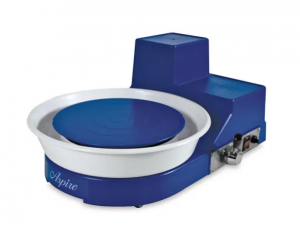
Shimpo Aspire Pottery Wheel
If you’d like something small and portable then this one is ideal.
You can it take to a pottery class or set yourself up anywhere, like your own backyard on a nice day, for example, the Aspire by Shimpo is the one to go for.
It comes complete with two 9-3/4″ (alloy) bats and a removable splash pan for easy clean-up.
Again the one we have featured is hand-operated. There is also a foot-operated model but to be honest, a hand-operated pottery wheel is a better choice for a beginner.
It means you won’t have to master any hand and foot coordination awkwardness while you are learning to throw.
And just as in our top pick, with this choice you can easily add a foot pedal later if you like.
The Ideal Starting Kit for New Hobbyists: YaeTek Electric Pottery Wheel Machine
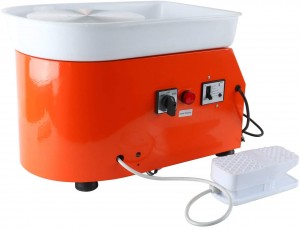
This choice is ideal if you’d like to just have a go at throwing on a pottery wheel, but don’t want to spend too much on a hobby.
Maybe you just want to have fun rather than get too serious about it.
The YaeTek is a solid choice, and for well under the $200 mark, (at the time of writing it’s under $150) it’s well worth the money.
You may be wondering why it costs less than our other options, so I take you through a rundown on what it doesn’t do first.
The slash pan is fixed, so although it is pretty easy to clean up, it’s not as easy as the Artista or the Aspire.
It also doesn’t come with any free bats, and, like most pottery wheels in this price range, there are no holes or pins on the wheel head to attach one.
You can, however, drill your own holes and buy a couple of bats separately. Just so you know, a bat will allow you to remove your piece while it’s drying, without risking any damage when taking it off the wheel head.
The YaeTek is foot operated. It’s also worth noting here, that hand-foot coordination can take a little while to master. That being said, the pedal is very responsive, and sooner or later you would most likely want to learn to throw with a foot pedal anyway.
One feature we really like about the YaeTek is its ability to go in both a forward and backward direction. This is great if you are left-handed but you will also find it handy for some throwing and decorating techniques.
All in all, for the price, it’s a good pottery wheel and what’s more, you don’t need to add legs or find a suitable table to position it on.
The Enthusiast’s Dream Setup: Brent Models IE, B, and C Power Wheels

Regarded as the Harley Davidson of the pottery wheel. Brent pottery wheels are renowned for their power, strength, and durability.
The company has been manufacturing pottery wheels in the US for more than 40 years.
Powder-coated steel legs to prevent corrosion in a moist atmosphere, along with a cast-aluminum foot pedal, a cast-aluminum wheel head, steel pins, and all-steel construction mean this baby is built to last!
Brent models feature both forward and reverse directions as well as the addition of a neutral setting – whereby the wheel can turn freely for banding and decorating. And this is a feature you just don’t get on cheaper pottery wheels.
What really sets this pottery wheel apart from the cheaper models out there, is its ability to maintain maximum torque – even with pressure and a heavy clay load.
This is because the controller automatically adjusts the wheel’s torque according to the amount of pressure that you apply to the clay. So there is no loss of torque – even when throwing a large amount of clay – and you don’t have to press the foot pedal down to compensate.
The two-piece splash pan is easily removable for a faster clean-up time.
Brent Pottery Wheels: The Difference Between Models IE, B, and C
The difference between model B and C comes down to the clay load it can handle, or to put it another way, the power behind the motor. Model B has a 1/2 HP motor and can continuously handle 150 lbs of clay, whereas model C has a 3/4 HP motor and a centering capacity of 250lbs.
For students of all levels, we recommend the IE with a reversing switch. This model has sturdy telescoping and lockable, legs which take the wheel from 13″ high when used as a tabletop wheel to 20–25″ when used on the floor.
The 1/4 HP permanent magnet DC motor and self-tensioning four-groove poly v drive belt drive will give you a smooth speed up and slow down, and a steady centering capacity of 75lbs of clay.
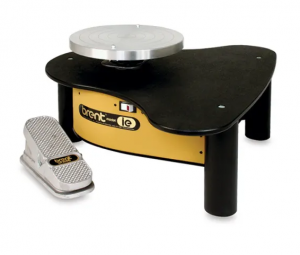
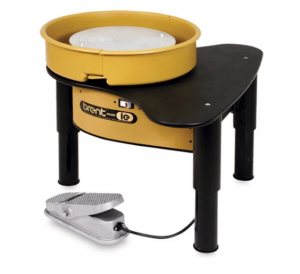
If you’d like to see it in action, take a look at the short video below.
As you can see from the video above, the Brent pottery wheel is a huge step up from the cheap imported pottery wheels out there.
But considering the sheer quality of their build, they are a worthwhile investment for anyone wanting to set up their own pottery studio at home.
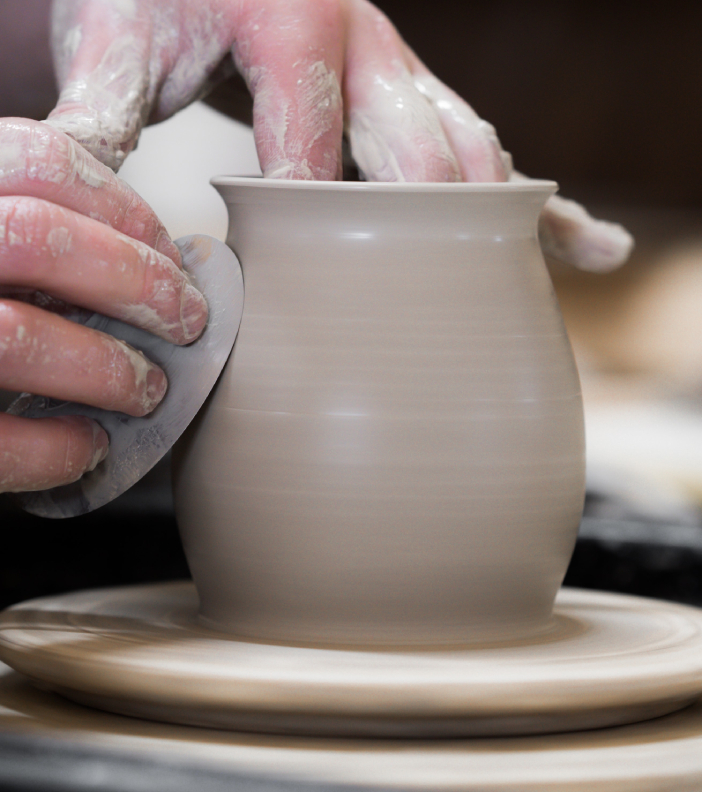
Leave a Reply